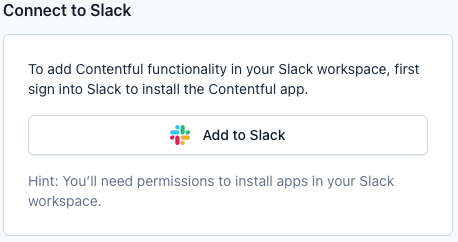Slack
The app for Slack allows you to be notified in Slack about content changes happening in Contentful. When editors make changes to entries of a particular content type, this app can automatically post these updates to a channel in your Slack workspace.
This way, editors are notified when content is created, updated, deleted, or published.
Overview
The app provides the following functionality:
Be notified when entries are (un)published, deleted, and created.
Selection of one or more channels to be notified.
Can be used for several different content types and events at the same time.
Requirements
To use this app, you need the following:
You must have permission to add apps to your Slack workspace.
You are authorized to add apps to a Slack channel.
The Contentful app is installed in Slack and invited to the channel where you want the app to post messages.
Usage
Go to the App Marketplace under Apps → Marketplace and search for the app for Slack.
After authorizing the app, you'll be redirected to the app installation and configuration screen.
From there, you need to follow the steps below to integrate the app with Slack.
Step 1: Install and configure
Click on the "Add to Slack" button to authenticate with Slack:

This authorizes the app to act on your behalf in API interactions from Contentful to Slack within the listed scope.

Step 2: Configure Contentful events for which you want to be notified
For every notification you set up, you can:
Select the content type you want the events to be linked to.
Select the Slack channel, you want the message to be sent to, in the dropdown. Make sure you add the Contentful app to that channel by inviting it. Only channels that have the Contentful app invited will show on the list.
Select the events you want to be notified for.

Step 3: Send messages
Trigger one of the selected events to be notified in the selected Slack channel:

Under the hood
Internally, the app does the following:
Authenticates with Slack via OAuth in the selected workspace.
Is installed to the connected workspace.
Asks you to select a content type and a channel.
Creates AppEvents for the selected events.
When an event occurs, sends a message in a specific format to the selected channel using the Slack message API.
Known Limitations
Content entries that are unusually large (greater than 65kb) may fail to trigger Slack notifications. We are working to address this limitation and eventually support entries up to 2mb in size (the current maximum supported size of content entries).